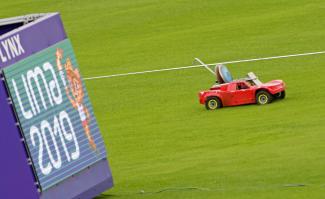
RUN, WE ARE FILMING YOU
Lima 2019 sports competitions broadcasts are possible thanks to about 270 cameras, as agile and fast as our athletes.

If you visit VIDENA these days, you might get confused and start thinking that Lima 2019 has included the operation of remote control cars as one of its sports disciplines. While the discus, hammer, bullet and javelin competitions are taking place, these cars go round and round in the central field of the Athletics Stadium.
But, these peculiar red cars are not operated by athletes, but by the camera operators of the great international team of Mediapro, the Host Broadcaster responsible for broadcasting all the Games sports competitions, as well as the opening and closing ceremonies. Of course, inside these cars, there are HD cameras instead of people.
“The car is nothing more than a high-speed horizontal traveling that allows them to reach athletes. In this case, they are operated by two people: one controls the car and the other the head (the camera). Normally, when it is not the high-speed version, someone can operate it all at once,” explained Gustavo Fonseca of Mediapro, coordinator in charge of covering all the Lima 2019 sports disciplines.
Sports in Screens
The group Mediapro has its own department of special cameras. Few television production companies research and develop their own technology, which allows them to be more operational. Thus, Mediapro’s display of technology has been important at Lima 2019. About 270 cameras have been used.
However, from a media perspective, there are particular sports that involve a greater challenge, such as swimming, gymnastics and, above all, athletics.
“Although we try to ensure that the production challenge of all sports is balanced, I think it is quite obvious that athletics is th king of the Games,” said Fonseca. “Several factors are involved: complexity, popularity, return of audience and, consequently, commercial return of the Right Holders, etc.”
In other important sports, such as gymnastics –which has already ended– and swimming, nearly 16 cameras were installed. In athletics, there were 24.
Race Cameras
Several wireless and mini cameras are located in many places of the Athletics Stadium. And then there are the most important ones:
OMNICAM SPEED is a high-speed traveling to track athletes in the 100 m race. It has a horizontal traveling with add-on engine to reach the speeds athletes reach, and a stabilizing lens that allows broadcasters to slow down the athletes’ movements.
“In swimming, for example, we also have another traveling, that is not high speed and has a double head: it features two cameras to track the swimmers' route, obviously with a much lower speed.”
OMNICAM FOR SKY is an aerial camera. It has a technology similar to that used by fly cams and spider cams. Mediapro has used two at Lima 2019: one in athletics and the other in the ceremonies.
Furthermore, the classic virtual graphics that we see on the screens is coupled to the cameras. This is widely used in swimming, jumping, and long distance athletics competitions. The camera has a system attached to its tripod that allows to vary the perspective and, consequently, the project virtual graphics in reality, so that jump distance can be seen on TV, and so on.
Past and Legacy
“I was not at Toronto 2015, but there are data that show the difference between those Games and Lima 2019: the number of live hours is double. We’ve broadcasted over 1200 hours live, and that is very different from what happened in the last Games,” assured Fonseca.
In addition, the amount of sports produced live and the distribution to Right Holders is significantly higher.
“All this historically creates a before and after Lima 2019. What we’ve seen here, in relation to the past, is very different. It had never happened before.”
Fonseca is also responsible for Mediapro's Local Operatives Training Program, which will leave a great legacy in terms of the expertise acquired by hundreds of Peruvians in sports broadcasting.
“It’s something that touches my heart. In the program, we trained 300 people thanks to the agreement that we established with the University of Lima and the casting we did to the local people. A hundred people joined our team. They’re working with us every day. It’s the legacy we leave. It’s in our DNA to teach them and then integrate them into our team. Some of them will go with us to the 2019 FIFA Beach Soccer World Cup in Paraguay in November. There will be Peruvian camera operators.”
